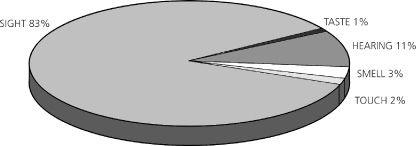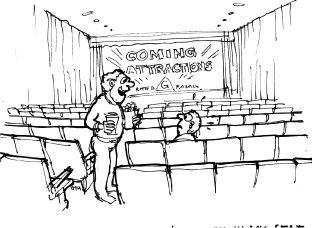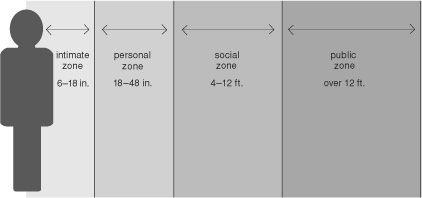The Definitive Book of Body Language (31 page)
Read The Definitive Book of Body Language Online
Authors: Barbara Pease,Allan Pease

When you are giving a visual presentation using books, charts, graphs, or a laptop it's important to know how to control where the other person is looking. Research shows that of the information relayed to the brain in visual presentations, 83 percent comes via the eyes, 11 percent via the ears, and 6 percent through the other senses.

Impact on the brain of information from the
senses during a visual presentation
The Wharton study in the United States found that the retention of verbal presentations was only 10 percent. This means that a verbal presentation requires frequent repetition of key points to be effective. By comparison, the retention rate of combined verbal and visual presentations is 50 percent. This means you will achieve a 400 percent increase in efficiency through the use of visual aids. The study also found that using visual aids cuts the average business meeting time from 25.7 minutes to 18.6 minutes—a 28 percent time saving.
To keep control of where a person is looking, use a pen to point to the presentation and, at the same time, verbalize what he sees. Next, lift the pen from the presentation and hold it between
his eyes and your eyes. This has the magnetic effect of lifting his head so that now he is looking at you and he sees and hears what you are saying, achieving maximum absorption of your message. Keep the palm of your other hand open when you are speaking.

The Power Lift—using the pen to control where a
person looks during a presentation
We also found that women hold more direct eye contact than men during presentations, especially when they are not talking. When women are talking, however, they avert their eyes more than men do.
Men stare more at women than vice versa and men give less direct eye contact when listening to other men than when listening to women.
Where you direct your gaze has a powerful impact on the outcome of a face-to-face encounter. If you were a manager who was going to reprimand an errant subordinate or a parent reprimanding a child, which gaze would you use? If you use Social Gazing, the sting would be taken out of your words, regardless of how loud or threatening you might try to sound. Social Gazing would weaken your words but Intimate Gazing could either intimidate or embarrass them. Power Gazing, however, has a powerful effect on the receiver and tells them you mean business.
Using the right gaze gives credibility.
What men describe as the “come-on” look that women use relates to a sideways glance, dilated pupils, and Intimate Gazing. If a woman wants to play hard to get, she needs to avoid using an Intimate Gaze and use Social Gazing instead. But most men miss a lot of it anyway. To use a Power Gaze during courting would leave a man or woman labeled as cold or unfriendly. When you use an Intimate Gaze on a potential partner, however, you give the game away. Women are expert at sending and receiving this gaze but, unfortunately, most men are not. When men use the Intimate Gaze it's usually blatantly obvious to women and men are generally unaware of having been given an Intimate Gaze by a woman, much to the frustration of the woman who gave it.
SPACE INVADERS—
TERRITORIES AND
PERSONAL SPACE

“Excuse me… but you're sitting in my seat!”
Thousands of books and articles have been written about the staking out and guarding of territories by animals, birds, fish, and primates, but only in recent years has it been discovered that man also has territories. When you understand the implications of this, you can gain enormous insights into your own behavior, and the face-to-face reactions of others can be predicted. American anthropologist Edward Hall was one of the pioneers in the study of man's spatial needs and in the early 1960's he coined the word “proxemics,” from “proximity” or nearness. His research into this field led to new understanding about our relationships with each other.
Every country is a territory staked out by clearly defined boundaries and sometimes protected by armed guards. Within each country there are usually smaller territories in the form of states and counties. Within these are even smaller territories
called cities and towns, within which are suburbs, containing many streets that, in themselves, represent a closed territory to those who live there. In the cinema it's an armrest where we do silent battle with strangers who try to claim it. The inhabitants of each territory share an intangible allegiance to it and have been known to turn to savagery and killing in order to protect it.
A territory is also an area or space around a person that he claims as his own, as if it were an extension of his body. Each person has his own personal territory, which includes the area that exists around his possessions, such as his home, which is bounded by fences, the inside of his motor vehicle, his own bedroom or personal chair, and, as Dr. Hall discovered, a defined air space around his body.
This chapter will deal mainly with the implications of this air space, how people react when it is invaded, and the importance of sometimes keeping an “arm's-length” relationship.
Most animals have a certain air space around their bodies that they claim as their personal space. How far the space extends depends mainly on how crowded the conditions were in which the animal was raised and the local population density. So personal territory can expand or contract depending on the local circumstances. A lion raised in the remote regions of Africa may have a territorial space with a radius of thirty miles, or more, depending on the density of the lion population in that area, and it marks its territory by urinating or defecating around the boundaries. On the other hand, a lion raised in captivity with other lions may have a personal space of only several yards, the direct result of crowded conditions.
Like most animals, each human has his own personal portable “air bubble,” which he carries around with him; its size is dependent on the density of the population in the place where he grew up. Personal Space is therefore culturally determined.
Where some cultures, such as the Japanese, are accustomed to crowding, others prefer the “wide-open spaces” and like you to keep your distance.

Personal space—the portable bubble we all carry around with us
Research shows that people in prisons appear to have larger personal space needs than most of the community, which results in the prisoners being constantly aggressive when approached by others. Solitary confinement, where no others are in the prisoner's space, always has a calming effect. Violence from passengers on aircraft increased during the 1990's when the airlines started packing people close together in the seats to compensate for revenue lost as a result of price discounting.
We'll now discuss the radius of the “air bubble” around suburban middle-class people living in places such as Australia, New Zealand, Great Britain, North America, Northern Europe, Scandinavia, Canada, or anywhere a culture is “Westernized” such as Singapore, Guam, and Iceland. The country in which you personally live may have larger or smaller territories than those we discuss here, but they will be proportionately the same as the ones we discuss here. Children have learned this spacing by age twelve and it can be broken down into four distinct zone distances:
1.
The Intimate Zone
between six and eighteen inches. Of all the zone distances, this is by far the most important, as it is this zone that a person guards as if it were his own property. Only
those who are emotionally close to us are permitted to enter. These include lovers, parents, spouse, children, close friends, relatives, and pets. There is a subzone that extends up to six inches from the body that can be entered only during intimate physical contact. This is the close Intimate Zone.
2.
The Personal Zone
between eighteen inches and forty-eight inches. This is the distance that we stand from others at cocktail parties, office parties, social functions, and friendly gatherings.
3.
The Social Zone
between four and twelve feet. We stand at this distance from strangers, the plumber or carpenter doing repairs around our home, the postman, the local shopkeeper, the new employee at work, and people whom we don't know very well.
4.
The Public Zone
is over twelve feet. Whenever we address a large group of people, this is the comfortable distance at which we choose to stand.

Personal Zone distances
All these distances tend to reduce between two women and increase between two men.
Our Intimate Zone (between six and eighteen inches) is normally entered by another person for one of two reasons: first, the intruder is a close relative or friend, or he or she may be making sexual advances; second, the intruder is hostile and may be about to attack. While we will tolerate strangers moving within our Personal and Social Zones, the intrusion of a stranger into our Intimate Zone causes physiological changes to take place within our bodies. The heart pumps faster, adrenaline pours into the bloodstream, and blood is pumped to the brain and the muscles as physical preparations for a possible fight-or-flight situation are made.